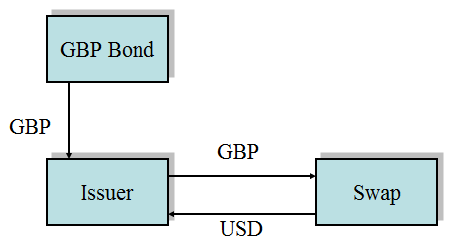
Barbican Consulting Limited
Basis Swaps

What is a basis swap?
A basis is swap is an interest rate or currency swap where both the payment of interest and receipt of interest are on a variable or floating rate basis.
Let’s see three examples:
1. Six month Libor swapped to one month Libor:

2. US Prime swapped to three month Libor:

3. US T-bill swapped to Libor:

What is clear from these swaps is that a dealer pays one index and receives another. The basis swap price is the spread in basis points added to or deducted from one side of the transaction. This price changes in accordance with market supply and demand.
These swaps are used to hedge index mismatches that can occur on the balance sheet. The risk of paying and receiving different indices is sometimes referred to as basis risk.
Why Basis Risk is Important
Managing basis risk is important because normally held assumptions about the interest differentials between indices can on occasion breakdown. This may lead to windfall gains and losses.
For example during the 2008 crisis the difference between three month GBP Libor and the Bank of England Base rate widened from about 20 basis points to 130 basis points. This was because as banks found it hard to borrow Libor rates increased relative to base rate.
For some banks this was beneficial. If they funded themselves using retail deposits linked to base rate and invested in assets linked to Libor. They had a windfall gain. This typically occurred where fixed rate asset portfolios were routinely hedged with swaps leaving the bank with a net receive Libor pay base rate position:

However other banks had a different position. They had funded themselves in the wholesale market paying Libor and had lent the money to retail customers at rates linked to base rate. As Libor increased these banks incurred windfall losses:

In hindsight the base rate versus Libor risk proved to be much greater than expected.
Probably the best way to manage this risk is to use “natural hedging” that is where the assets and liabilities have similar interest rate indices.
However if this is not possible basis swaps can be used:

The basis swap, depending on the market pricing, normally has a number of basis points added to the base rate linked payment.
Why Basis Swap Prices are Important
Basis swap prices should be factored into the business being conducted. For example in a cross currency basis swap there is principal exchange at the start and at maturity of the deal. Libor is then paid in one currency and received in the other:

You may expect USD Libor to be exchanged for GBP Libor with no additional basis points or spread being added to either side (USD Libor flat versus GBP Libor flat). However often this is not the case and a spread is added to or deducted from the GBP Libor side.
If the current market price on this swap was USD Libor flat versus GBP Libor plus 5 basis points it would have important consequences for a GBP bond issuer who swapped the bond proceeds to USD.
There is exchange of principal at the start (and a re-exchange at maturity):

The interest payments are:

The issuer (borrower) receives an additional 5 basis points (0.05%) over and above GBP Libor.
For a deal of £1 billion this is worth £100,000 x 5 = £500,000 per annum. A present value (using a 3% interest rate) of £2.3 million.
The extra five basis points would be used to lower the all in cost of borrowing.
Failure by the issuer to correctly recognise the basis swap price would be expensive!
First Published by Barbican Consulting Limited 2008